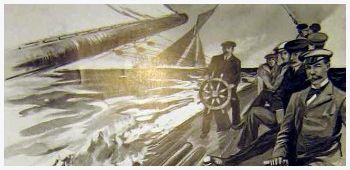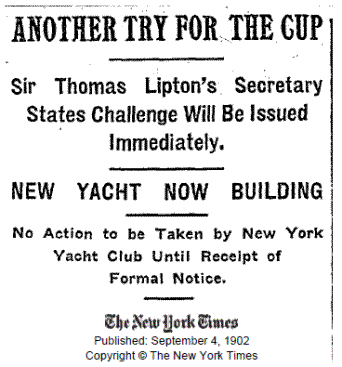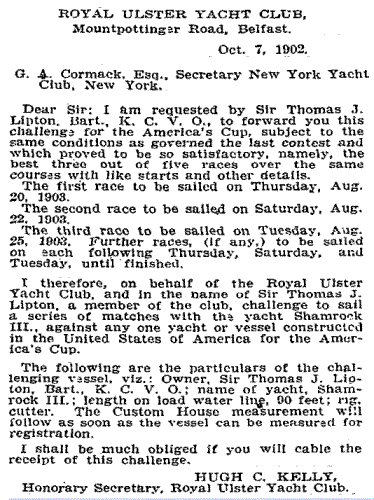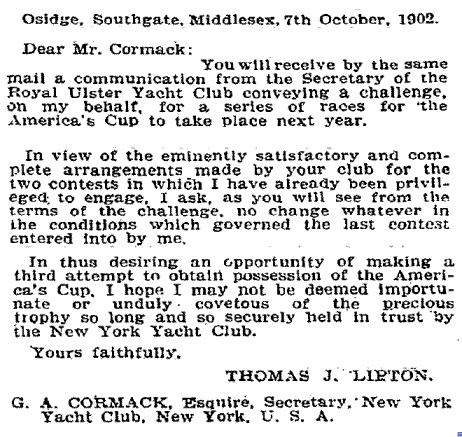Yves GARY Hits: 3287
Category: 1903 : CHALLENGE N°12
 After the Cup Race of 1901 it began to be apparent to everyone who had followed yacht racing closely that the limit to which everything could be sacrificed for speed in racing yachts had about been reached.
After the Cup Race of 1901 it began to be apparent to everyone who had followed yacht racing closely that the limit to which everything could be sacrificed for speed in racing yachts had about been reached.
The tendency in Cup defenders was naturally reflected in smaller yachts, and, on the whole, a very unsatisfactory type of racing boat was being developed.
 Dissatisfaction with this tendency was already becoming apparent, though it took another Cup race, and a still more extreme type of defender, to bring it to a head and to lead to the adoption of a measurement rule that put a stop to the flat, scow-like racing shells with which amateur sailors were inflicted if they wanted to race.
Dissatisfaction with this tendency was already becoming apparent, though it took another Cup race, and a still more extreme type of defender, to bring it to a head and to lead to the adoption of a measurement rule that put a stop to the flat, scow-like racing shells with which amateur sailors were inflicted if they wanted to race.
After Lipton returned to England he waited a decent interval to allow anyone else who might be covetous of the Americas Cup to make a "try" for it; but no one came forward. The cost of a race was getting to be prohibitive with the chances of success very slim and the return in sport altogether incommensurate with the outlay, the boats being useless except for this one event. America's Cup racing was not particularly popular, just then.
 The following summer word came that Sir Thomas Lipton was making plans for another assault on the New York Yacht Club, and in due time a third challenge arrived from the Royal Ulster Yacht Club, asking for a race in August, 1903, and naming another ninety- foot cutter as the boat. Accompanying this
The following summer word came that Sir Thomas Lipton was making plans for another assault on the New York Yacht Club, and in due time a third challenge arrived from the Royal Ulster Yacht Club, asking for a race in August, 1903, and naming another ninety- foot cutter as the boat. Accompanying this  challenge of October 7th, 1902, Sir Thomas sent a personal letter to the New York Yacht Club regarding his persistence in trying to " lift " the Cup, in which he said: " In thus desiring an opportunity of making a third attempt to obtain possession of the America's Cup I hope I may not be deemed importunate or unduly covetous of the precious trophy so long and so securely held in trust by the New York Yacht Club." These were fine words, and showed a true spirit of sportsmanship in the face of two defeats.
challenge of October 7th, 1902, Sir Thomas sent a personal letter to the New York Yacht Club regarding his persistence in trying to " lift " the Cup, in which he said: " In thus desiring an opportunity of making a third attempt to obtain possession of the America's Cup I hope I may not be deemed importunate or unduly covetous of the precious trophy so long and so securely held in trust by the New York Yacht Club." These were fine words, and showed a true spirit of sportsmanship in the face of two defeats.
No trouble was had in arriving at an understanding as to the terms of the match; the conditions asked for and granted being practically the same as in the previous races. The series was to consist of the best three out of five races with the usual five and one half hour time limit.
 |
On the left: the formal challenge from the Royal Ulster Yacht Club. On the right: the letter from Sir Thomas Lipton accompanying the challenge.  |
